
The Bristol Perseus was a British nine-cylinder, single-row, air-cooled radial aircraft engine produced by the Bristol Engine Company starting in 1932. It was the first production sleeve valve aero engine.

The Gotha G.V was a heavy bomber used by the Luftstreitkräfte during World War I. Designed for long-range service and built by Gothaer Waggonfabrik AG, the Gotha G.V was used principally as a night bomber.

The AEG G.IV was a biplane bomber aircraft used in World War I by Germany. It was developed from the AEG G.III, with refinements to power, bomb-load and dimensions. Coming into service in late 1916, it featured a bomb capacity twice as large as that of the AEG G.II, but was still considered inadequate in terms of offensive capacity and performance. Further improvements led to the development of the G.V, but the Armistice came before the replacement could become operational. Serving late in the war, the AEG G.IV managed to achieve some operational success in reconnaissance and combat roles.
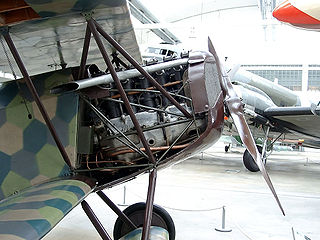
The Mercedes D.III, or F1466 as it was known internally, was a six-cylinder SOHC valvetrain liquid-cooled inline aircraft engine built by Daimler and used on a wide variety of German aircraft during World War I. The initial versions were introduced in 1914 at 160 hp, but a series of changes improved this to 170 hp in 1917, and 180 by mid-1918. These later models were used on almost all late-war German fighters, and its only real competition, the BMW III, was available only in very limited numbers. Compared to the Allied engines it faced, the D.III was generally outdated.

The Mercedes D.II was a six-cylinder, SOHC valvetrain liquid-cooled inline aircraft engine built by Daimler during the early stages of World War I. Producing about 110 to 120 hp, it was at the low-end of the power range of contemporary engines, and was generally outperformed by rotaries whose power-to-weight ratio tended to be much better. It also had stiff competition from the Ferdinand Porsche-designed 120 hp Austro-Daimler 6. The D.II was produced only briefly as a result, but its design formed the basis for the later Mercedes D.III which saw widespread use throughout the war.
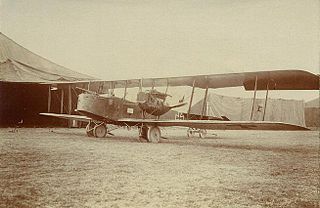
The Friedrichshafen G.III was a heavy bomber designed and manufactured by Flugzeugbau Friedrichshafen. They were used by the German Imperial Air Service during World War I for tactical and limited strategic bombing operations. After the end of the war a number of Friedrichshafen bombers were converted into transport aircraft while a small number also saw service as dedicated airliners.

The Mercedes D.IV was an eight-cylinder, liquid-cooled inline aircraft engine built by Daimler Motoren Gesellschaft (DMG) and used on a small number of German aircraft during World War I.
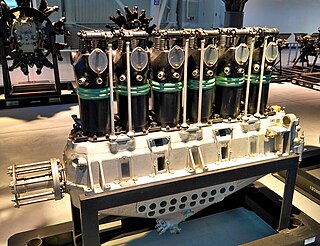
The Benz Bz.IV was a German six-cylinder, water-cooled, inline engine developed for aircraft use. Deliveries began in 1916, and some 6,400 were produced.
The Mercedes D.I was a six-cylinder, water-cooled, SOHC valvetrain inline engine developed in Germany for use in aircraft in 1913. Developing 75 kW (100 hp), it powered many German military aircraft during the very early part of World War I.
The Benz Bz.III was a six-cylinder, water-cooled, inline engine developed in Germany for use in aircraft in 1914. Developing 112 kW (150 hp) at 1,400 rpm from 14.3 L, it powered many German military aircraft during World War I. It was replaced in production by the unrelated Benz Bz.IIIa. and eventually the V-8 Benz Bz.IIIb. The Benz Bz.III was built under licence in Sweden by AB Thulinverken, known as the Thulin E.
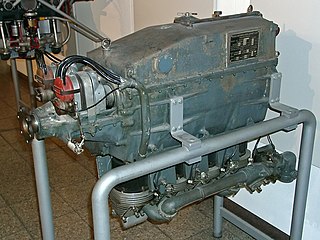
The Argus As 8 was a four-cylinder, air-cooled, inverted inline aircraft engine produced in Germany by Argus Motoren in the 1930s.

The Friedrichshafen G.IV and G.V respectively were heavy bombers that were designed and manufactured in Germany during World War I by Flugzeugbau Friedrichshafen. The G.IV saw limited use by the Luftstreitkräfte for tactical and limited strategic bombing operations, while the G.V and a follow-on design, the FF.62 did not fly until after the Armistice.

The Gotha G.III was a twin-engine pusher biplane heavy bomber used by the Luftstreitkräfte during World War I. It succeeded the G.II in production and differed primarily in powerplant and in armament details. The G.II's unreliable V-8 Mercedes D.IV was replaced by the new inline six-cylinder 190 kW (250 hp) Mercedes D.IVa engine. The G.III also had a strengthened fuselage with an extra 7.92 mm (0.312 in) machine gun firing through a ventral gun tunnel in the belly to protect the underside of the tail.

The Gotha G.IV was a heavy bomber used by the Luftstreitkräfte during World War I. It was the first mass-produced relatively large airplane.
The Hirth HM 506 was a six-cylinder air-cooled inverted inline engine that was developed from the earlier four-cylinder HM 504. The HM 506 was a popular engine for light aircraft of the 1930s to 1940s and powered the Bücker Bü 133A model trainer. The engine featured a cast magnesium alloy crankcase.
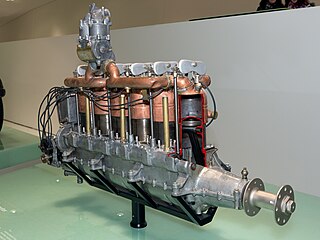
The Austro-Daimler 6 was a series of Austrian six-cylinder water-cooled inline aero engines first produced in 1910 by the Austro-Daimler company.

The Beardmore 160 hp is a British six-cylinder, water-cooled aero engine that first ran in 1916, it was built by Arrol-Johnston and Crossley Motors for William Beardmore and Company as a development of the Beardmore 120 hp, itself a licensed-built version of the Austro-Daimler 6.

The Walter Regulus was a Czechoslovakian five-cylinder, air-cooled radial engine for powering light aircraft that first ran in 1934. The engine produced 186 kW.
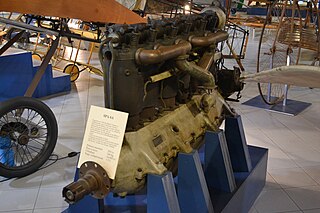
The SPA 6A is an Italian water-cooled inline six-cylinder aero engine of the World War I era. The SPA 6A is mostly known for its use in the Ansaldo SVA high speed reconnaissance aircraft.
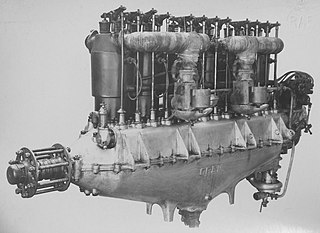
The Argus As III was a six-cylinder, in-line, water-cooled, aircraft engine produced in Germany by Argus Motoren during World War I. The Argus As III produced 180 hp (130 kW) at 1,400 rpm.

















